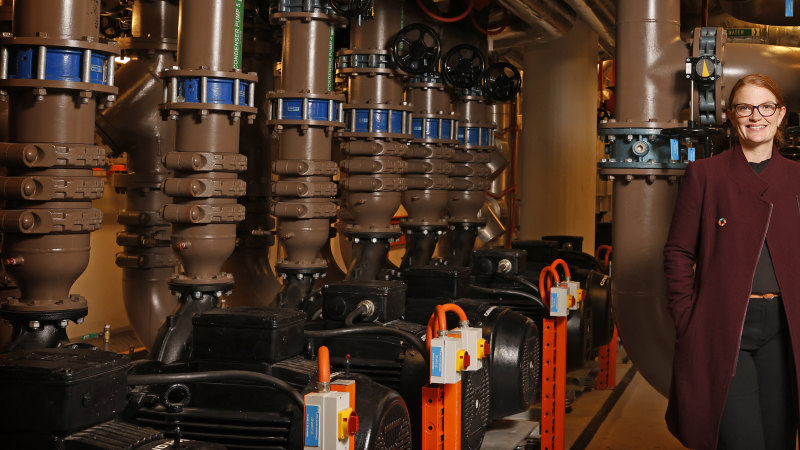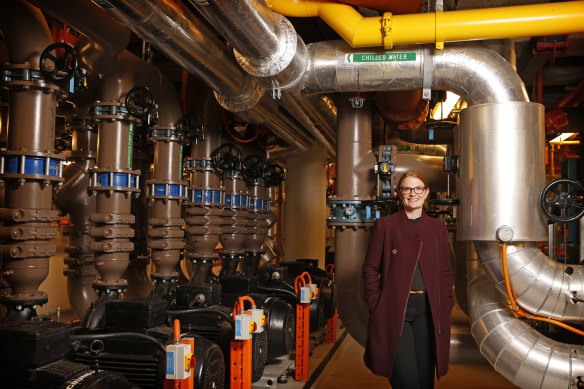Save articles for later
Add articles to your saved list and come back to them any time.
Each day she comes to work at the Sydney Opera House, manager of environmental sustainability Emma Bombonato thanks architect Jorn Utzon for making her job that little bit easier.
When he won the international design competition to build it in 1957, Utzon included plans for a state-of-the-art heating and cooling system using seawater from Sydney Harbour.
Sydney Opera House Environmental Sustainability Manager Emma Bombonato, with some of the 35 kilometres of pipes that heat and cool the building.Credit: Dylan Coker
He recruited fellow Danish designers Steensen Varming to install 35 kilometres of pipes in the bowels of the building, so the seawater could circulate via fans and pumps, creating a world-first large-scale heating and air-conditioning system.
That foresight has this month helped the Sydney Opera House win a 6 Star Green Star performance rating by the Green Building Council of Australia, one of the first World Heritage-listed buildings globally to have earned this highest possible environmental certification.
“Jorn Utzon and engineers wanted to come up with an innovative way to heat and cool the building which we are very grateful for because even over 50 years later, it is still considered efficient technology, ahead of its time and enables us to reduce our emissions,” Bombonato said.
Not only was it energy efficient, it was aesthetically pleasing and meant the building was free from unsightly air-conditioning units and heaters.
“The chiller plant that houses the seawater cooling system is a really important way we reduce our energy use and carbon emissions, as our electricity contributes over 80 per cent of our carbon footprint,” Bombonato said.
“Louise Herron, our CEO, will often refer to the Concert Hall as the soul of the building. But we often talk about the chiller plant as being the hearts and lungs.”
Green Building Council of Australia chief executive Davina Rooney said the Opera House had improved its rating since it earned a 4-star badge in 2015.
“This is proof that any building – old or new, big or small – can reach the highest sustainability outcomes. This achievement deserves a standing ovation,” Rooney said.
Other environmental improvements include the building switching to 100 per cent renewable electricity, eliminating single-use plastic takeaway packaging from all venues and restaurants, diverting 95 per cent of event waste from landfill for Vivid LIVE and outdoor concerts in 2022 (and on track for 2023).
It has also maintained carbon-neutral status year-on-year since 2018, increased operational waste recycling rate from 55 per cent to more than 90 per cent, installed an artificial reef in the waters around Bennelong Point to restore habitat and increase marine biodiversity, and reduced electricity and water usage by about 20 per cent since 2018.
“The Opera House’s 6 Star Green Star certification highlights the remarkable progress this world-famous building has made in reducing its environmental impact as well as its broader commitment to long-term sustainability,” said NSW Minister for the Arts and Minister for Music and Night-time Economy, John Graham.
Sydney Opera House CEO Louise Herron said the building could now be used as a model for others.
“We hope our focus on sustainability, which is part of the Opera House’s DNA, will help inspire organisations everywhere, big and small, to create positive change.”
GREENING THE HOUSE
- The Opera House produces 1000 tonnes of waste annually (25 semi-trailers full) with 80 per cent from food and beverage.
- Food waste is composted offsite in Wollongong.
- About 60 per cent of electricity is related to heating and cooling – which is why Jorn Utzon’s innovative seawater cooling is integral to efficient energy performance.
- On average, the Opera House uses 60 megalitres of water per year – enough to fill 23 Olympic swimming pools.
- The underwater artificial reef structure has attracted marine species such crimson wrasse, estuary stingray, hulafish, the gloomy octopus, and the endangered white’s seahorse.
- Environmentally friendly cleaning products such as 45 litres of olive oil are used to polish the brass, and nine litres of bicarb soda to clean the concrete.
- All venues are now free of single-use plastic packaging.
Get to the heart of what’s happening with climate change and the environment. Our fortnightly Environment newsletter brings you the news, the issues and the solutions. Sign up here.
Most Viewed in Environment
From our partners
Source: Read Full Article

